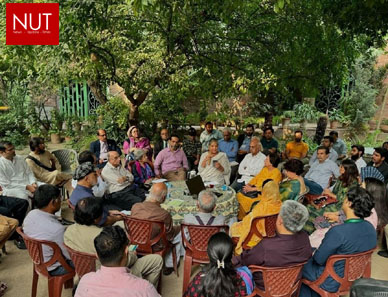The 13th Annual International THAAP Conference entitled *Rivers of Harappa* wrapped up its two-day proceedings, providing a vital platform for scholars to explore the cultural heritage and historical significance of the Harappan civilization. With 16 papers presented across five sessions, the conference delved into diverse facets of Harappan life, art, and symbolism, enriching participants’ understanding of one thw world’s most enduring civilization.
The fourth paper reading session was chaired by Professor Dr. Kanwal Khalid, who set a thought-provoking tone for the discussions. The first speakers, Najia Sarwar and Maheen Yousaf, propose coloring historical narrative by tracing the generational legacy of Indigo dye and thus the cradle of indigo cultivation in Harappan civilization. In the insightful paper entitled “Indigo as a Milieu of Harmony and Sustainability” researchers traced the role of indigo dye in Harappan textiles, illustrating how this ancient craft of dyeing became a unifying element within Harappan society and connects past practices with lasting textile traditions.
Following Najia Sarwar and Maheen Yousaf, Architect Muhammad Abdullah presented his paper titled “Echoes of the Past: Tracing Harappan Cultural Elements in Punjabi Folk Songs.” Abdullah explored the symbolic connections between Harappan motifs and Punjabi folk songs, emphasizing how Harappan culture continues to resonate in regional folklore.
In a thought-provoking contribution, professor Dr. Kanwal Khalid highlighted conventional archaeological narratives in his own paper, “Unlearning of Learning: Dimensions of Harappan Excavations.” She argued for recognition of oral traditions and folk customs as essential sources, promoting a more holistic understanding of Harappa beyond physical artifacts.
The fifth paper reading session, chaired by Dr. Tohid Ahmad Chattha provided profound insights into the artistic, cultural, and symbolic significance of rivers in Harappan civilization. Ayesha Latif introduced her paper, “Reading the Motif of the River in Punjabi Sufi Poetry,” examining how river symbolism in Sufi poetry, especially that of poets like Shah Hussain and Bulleh Shah, mirrors Harappan reverence for water, blending ancient beliefs with later spiritual themes.
Following her Maheen Yousaf presented her paper titled “Transcending Boundaries of the Harappan Rivers through the Trefoil Motif.” She analyzed the trefoil symbol, found across several ancient cultures, including Harappa, proposing that it serves as a shared emblem linking diverse societies through a common artistic language.
Dr. Tohid Ahmad Chattha closed the session with his research titled “Textile Traditions and Riverine Influences: Reconstructing ‘A Punjabi Saropa’ through Harappan Designs.” Chattha focused on the lasting impact of Harappan textile patterns on modern Punjab, presenting a reconstructed “Punjabi Saropa” indigenous design used in historical monuments such as shahlamar garden, homes, buildings and cultural blankets etc that showcases the resilience of these ancient designs. Contributing to the session, Raza Naeem presented insights from Mustansar Hussain Tarar’s novel “Bahao” examining Harappan women’s roles as creators and preservers. His analysis connected Tarar’s literary work to historical Harappan figures, highlighting the civilization’s artistic and cultural legacy.
The conference concluded with an engaging Harappa Circle round table discussion, where all the participants explored the relevance of oral heritage and tradition in recontextualizing archaeological and anthropological narratives of Harappa. This open forum encouraged lively exchanges, emphasizing the importance of diverse perspectives in understanding the complexities of Harappan society. Prof. Pervaiz Vandal and Prof. Sajida Vandal in their closing remarks, expressed gratitude for the attendees’ contributions, underscoring THAAP’s dedication to promoting historical understanding and appreciation of Harappa’s enduring legacy. The two-day event celebrated the rich narratives of the Harappan civilization, further solidifying THAAP’s role in fostering scholarly dialogue and research in this crucial area of cultural heritage.

